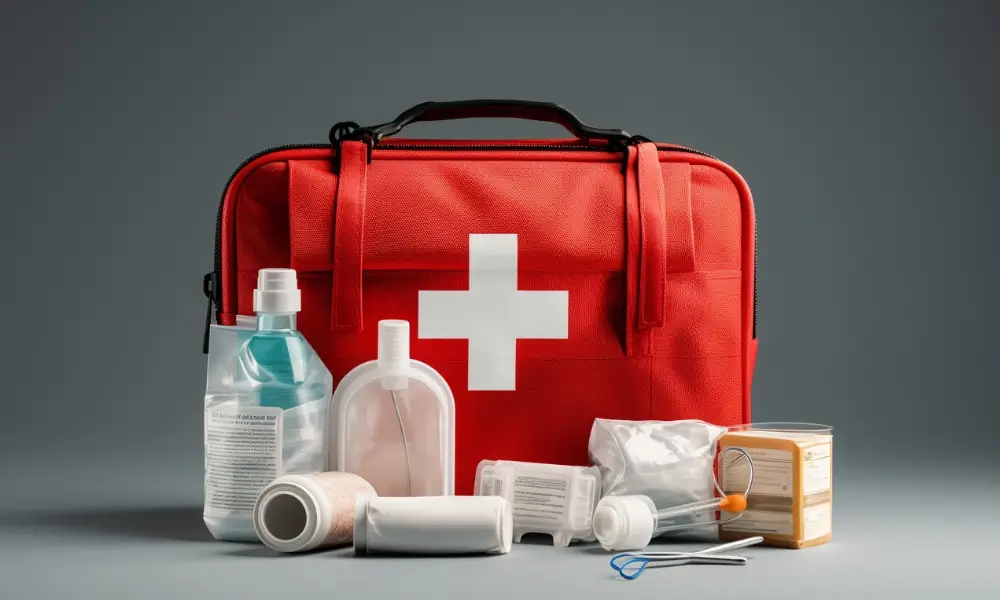Emergencies are unpredictable by nature, making preparation key. An integral part of being prepared is understanding first aid essentials and ensuring access to a properly equipped kit. Whether in the comfort of your home, busy at work, or adventuring in the great outdoors, a first aid kit can be a vital tool. In this comprehensive blog post, we will dive into the concept of the first aid kit, unpacking its importance in various scenarios and understanding how it can be the difference between a minor and a major health event.
However, having a first aid kit isn’t just about owning a box of medical supplies. It’s about understanding its contents and knowing how to use them. That’s why we’re taking this discussion a step further. We will explore the top ten essential items that should find a place in every first aid kit. We will delve into the significance of each item, from adhesive bandages to a thermometer, explaining their functions and specific roles in medical care.
By the end of this blog post, we aim to arm you with a checklist for your first aid kit and the knowledge of how to use each item effectively. Embark on this journey with us towards better preparedness and knowledge – it’s more than just informative; it could save a life!
What is a First Aid Kit?
A first aid kit is a collection of supplies and equipment for immediate medical care. It’s designed to manage minor injuries and illnesses until professional medical help can be obtained or in emergencies where professional help may not be immediately available. First aid kits can be small and portable, intended for personal use, or they can be larger and more comprehensive, intended for use in places like homes, schools, workplaces, and public spaces.
While the contents of a first aid kit can vary based on the needs of those it’s intended to serve, a basic first aid kit often includes items like adhesive bandages, sterile gauze pads, adhesive tape, tweezers, scissors, disposable gloves, antiseptic wipes or solution, over-the-counter pain relievers, a thermometer, and a CPR face shield or pocket mask.
First aid kits can also be customized based on specific needs or activities. For instance, a first aid kit for hiking might include items for treating blisters and insect bites, while a kit for a home with young children might include items for treating minor cuts and burns.
What Are 10 Items In A First Aid Kit?
A well-stocked first aid kit is essential for handling minor injuries and emergencies. Here are 10 essential items you should have in a basic first-aid kit:
1. Adhesive Bandages (Plasters)
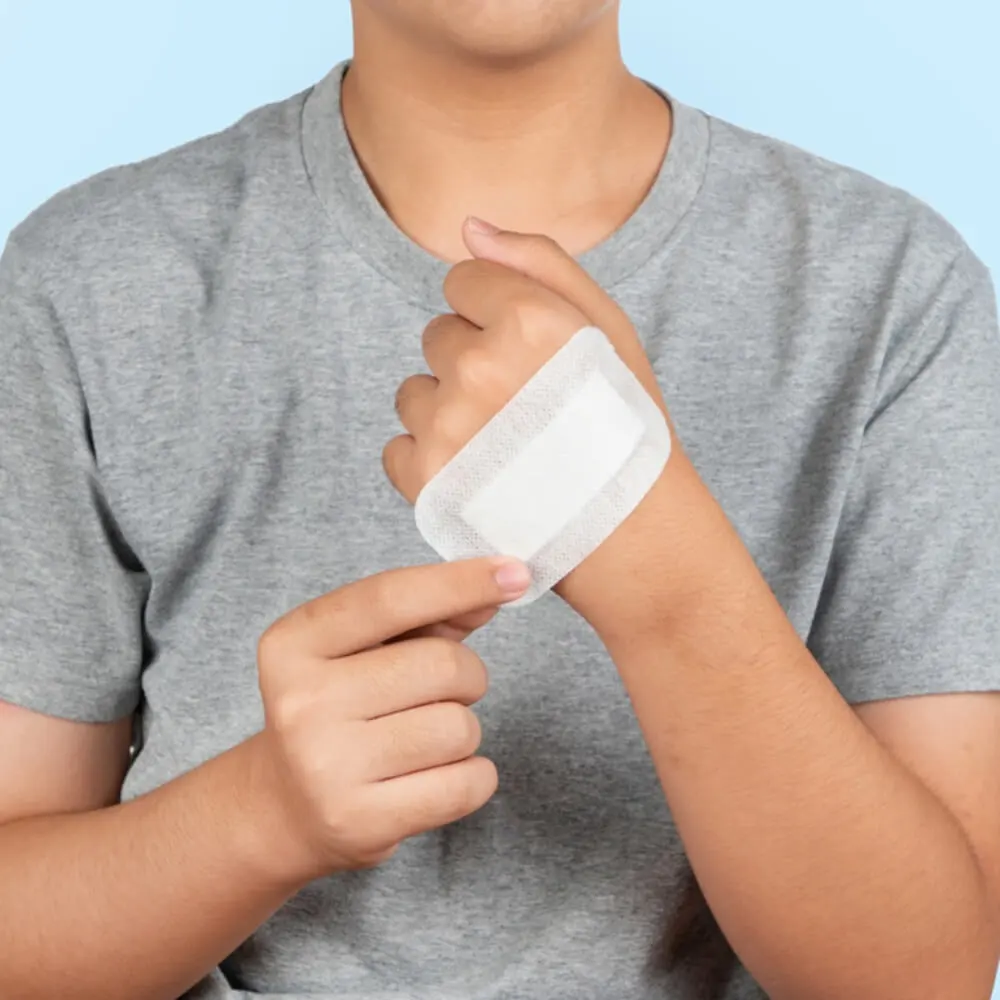
Adhesive bandages, often known by brand names such as Band-Aid, are a dressing used for minor wounds like cuts, scrapes, and blisters. The main purpose of an adhesive bandage is to protect the wound from further injury and to prevent the entry of bacteria, which can lead to infection.
The bandage has three key parts:
- A pad or gauze is part of the bandage that is directly applied to the wound. The gauze absorbs any blood, pus, or other fluids, thereby aiding in the healing process.
- An adhesive strip that holds the pad in place. This adhesive is usually designed to be gentle on the skin but strong enough to keep the bandage secure.
- A plastic or fabric outer surface protects the wound from outside contamination.
Some adhesive bandages also contain antiseptic agents to disinfect the wound and/or are made from waterproof material to protect the wound in wet conditions.
While adhesive bandages are great for minor injuries, larger or more severe wounds may require more advanced dressings or medical attention.
2. Sterile Gauze Pads
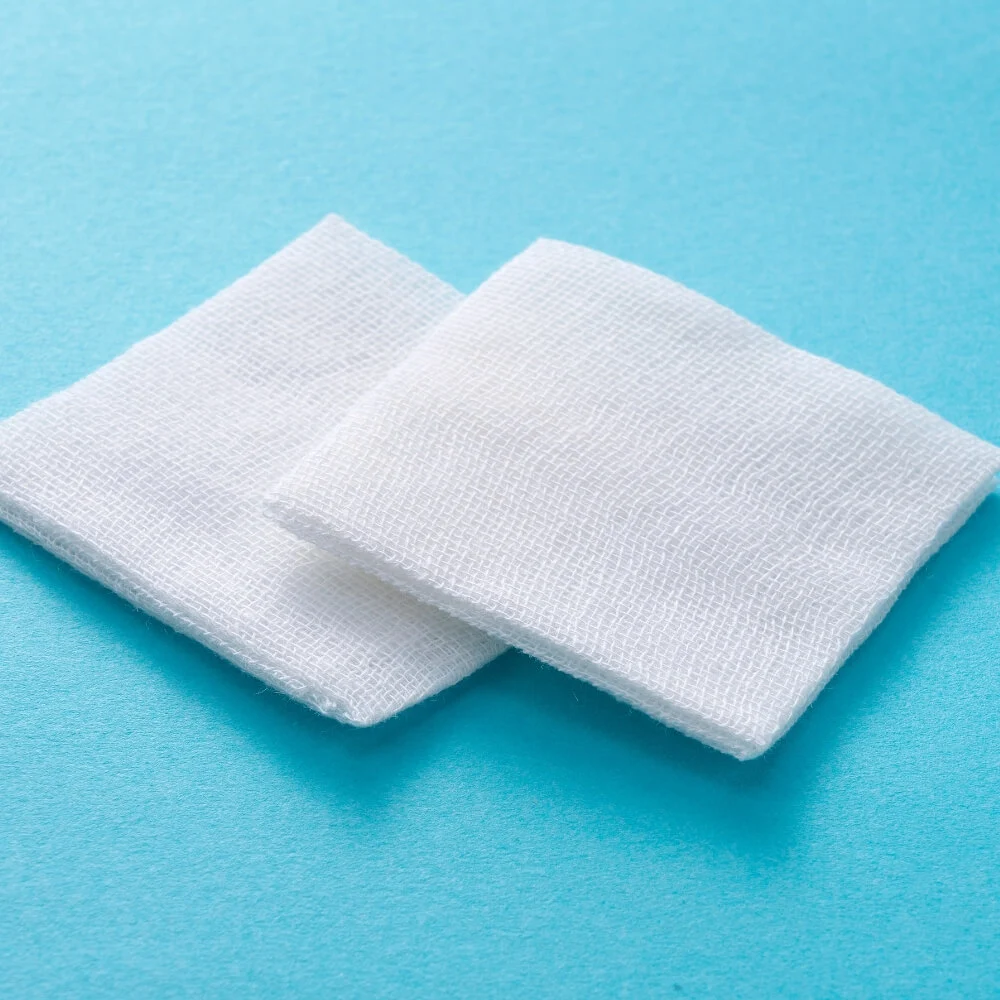
Sterile gauze pads are essential to a first aid kit and are used for several purposes in wound care. They are made from a woven material, usually cotton, and are designed to be highly absorbent and gentle on the skin.
- Dressing Wounds: Gauze pads are used to dress larger wounds that cannot be covered by a simple adhesive bandage. They can absorb more blood and exudate (the fluid that may ooze from a wound), which makes them suitable for more severe injuries. Using a gauze pad as a wound dressing, you would clean the wound, place it over it, and then secure it using adhesive tape or a bandage.
- Cleaning Wounds: Gauze can also be used to clean a wound. You can moisten it with a saline solution or antiseptic, then gently clean around and in the wound to remove dirt or debris. This helps to reduce the risk of infection.
- Applying Pressure: If a wound is bleeding heavily, a gauze pad can be used to apply pressure to help stop or slow the bleeding. You would place the gauze pad over the wound and apply firm pressure.
- Protecting Wounds: By covering a wound, gauze pads can protect it from being disturbed or coming into contact with dirt and bacteria, thus reducing the risk of infection.
When using gauze pads, it’s important to change them regularly and as soon as they become wet or soiled. It’s also crucial to note that gauze pads are for single use only and should be discarded after use. Always wash your hands thoroughly before and after dressing a wound to prevent infection.
3. Adhesive Tape
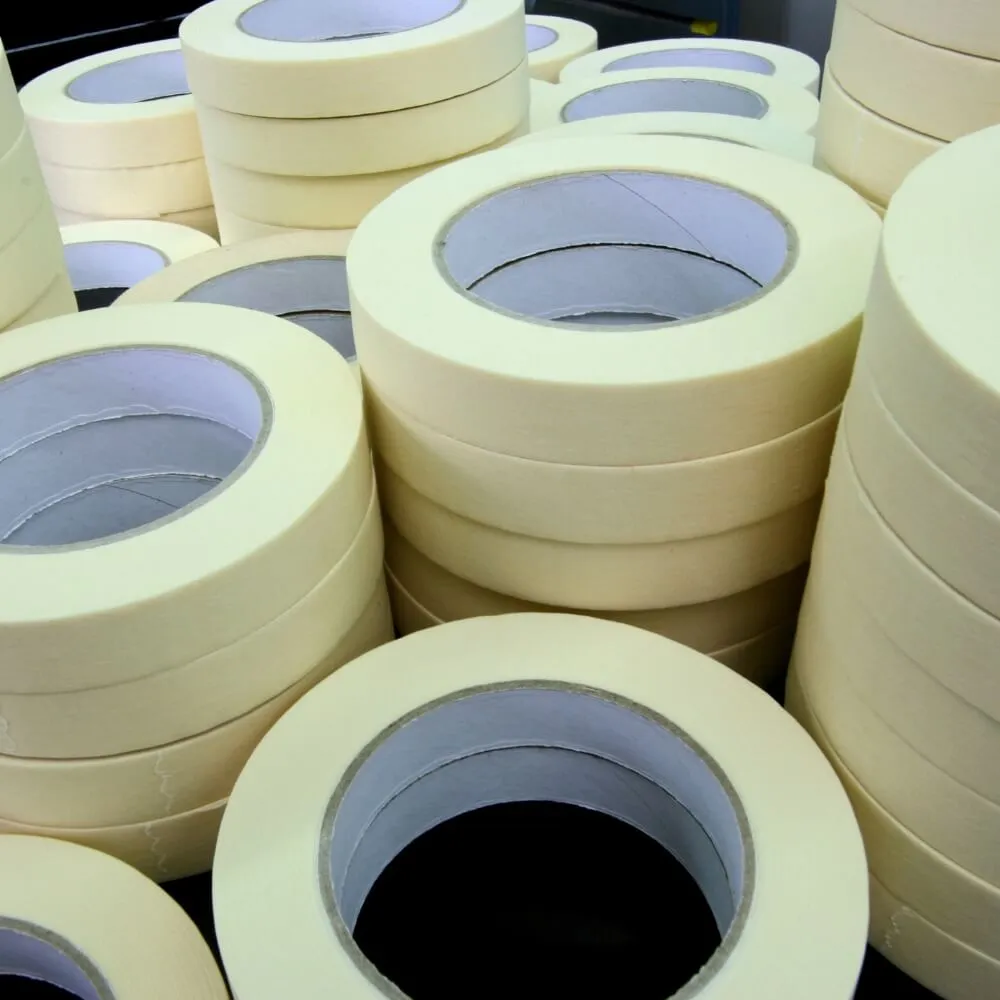
Adhesive tape, also often referred to as medical tape, is a type of pressure-sensitive adhesive tape used in medicine and first aid to hold dressings or bandages onto a wound. Its main purpose is to secure the primary dressing (like a gauze pad) over a wound.
The tape can be made from various materials, including cloth, paper, or plastic. Some are designed to be very flexible and conform to the body’s curves, while others are more rigid. The adhesive used is usually hypoallergenic to prevent skin reactions.
There are also different types of medical adhesive tape for different uses:
- Cloth Tape: This type of tape is quite durable and perfect for holding dressings with flexibility.
- Paper Tape: This type of tape is very gentle on the skin, making it ideal for people with sensitive skin or use on delicate areas like the face. However, it’s not as strong or durable as other types.
- Plastic Tape: This waterproof type of tape is good for dressings that must be kept dry.
- Zinc Oxide Tape: This rigid tape is often used to prevent sports injuries by supporting muscles and joints.
The choice of which type of adhesive tape to use depends on the situation and the individual. When removing adhesive tape, it’s important to do so gently and ideally while supporting the skin to reduce discomfort. If the tape is stubborn, an adhesive remover or warm water can weaken the adhesive and make removal easier.
4. Tweezers
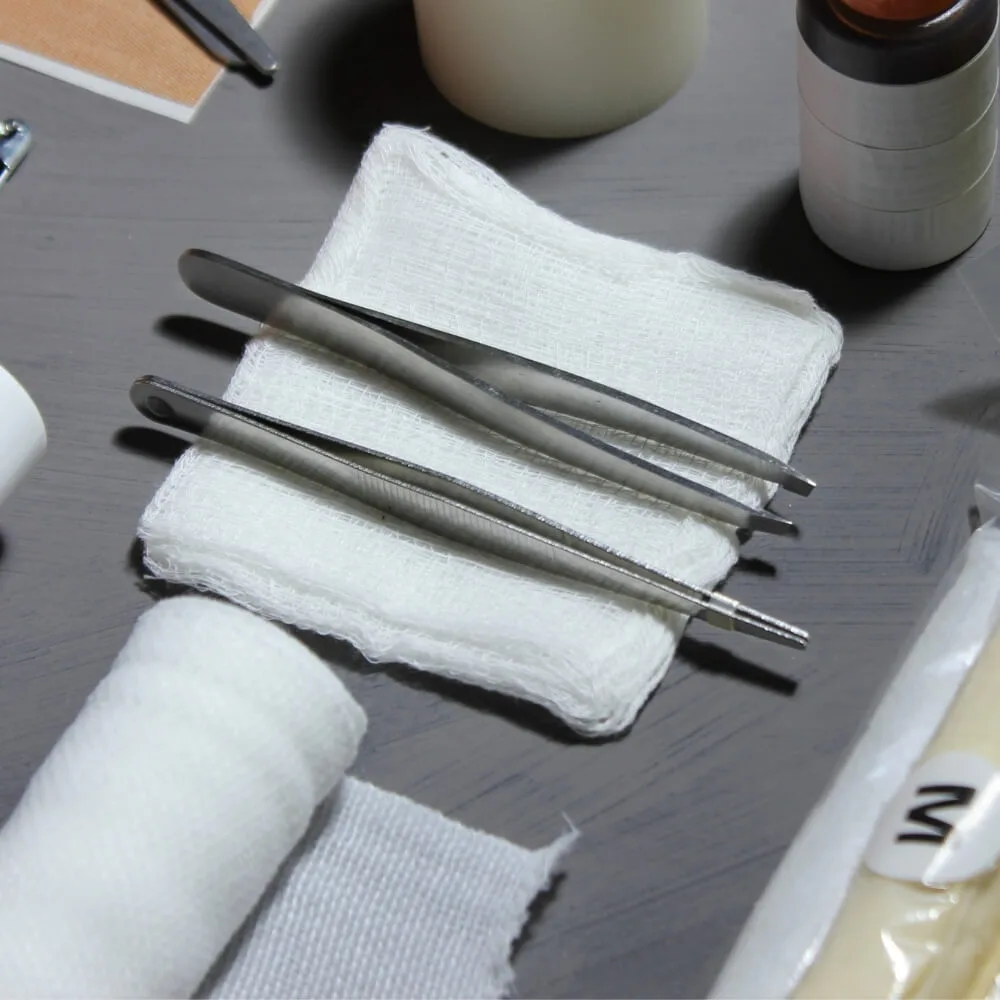
Tweezers are a small tool for picking up objects too small to handle with human hands. In a first aid context, they’re most often used for removing small foreign bodies, such as splinters, glass shards, or tiny pieces of debris, from a wound.
The tweezers in a first aid kit should ideally have a pointed tip, allowing for more precise control when removing something small or embedded in the skin. Some kits may include plastic tweezers, but metal (such as stainless steel) is more durable and can be sterilized easily.
Before using tweezers to remove a foreign object from a wound, cleaning both the wound and the tweezers is crucial. This can usually be done with warm water and soap for the wound and rubbing alcohol for the tweezers to prevent introducing more bacteria into the wound and causing an infection.
When using tweezers, the aim should be to remove the object without causing more injury or pushing the object deeper into the tissue. Pulling in the same direction that the object entered is important to minimize damage to surrounding tissues.
Once the foreign body is removed, the wound should be cleaned again, an antiseptic should be applied, and the wound should be covered with a clean bandage. If the object is large, deeply embedded, or uncertain, it’s best to seek medical attention instead of trying to remove it yourself. The same goes if signs of infection (like increased pain, redness, pus, or swelling) develop after removal.
5. Scissors
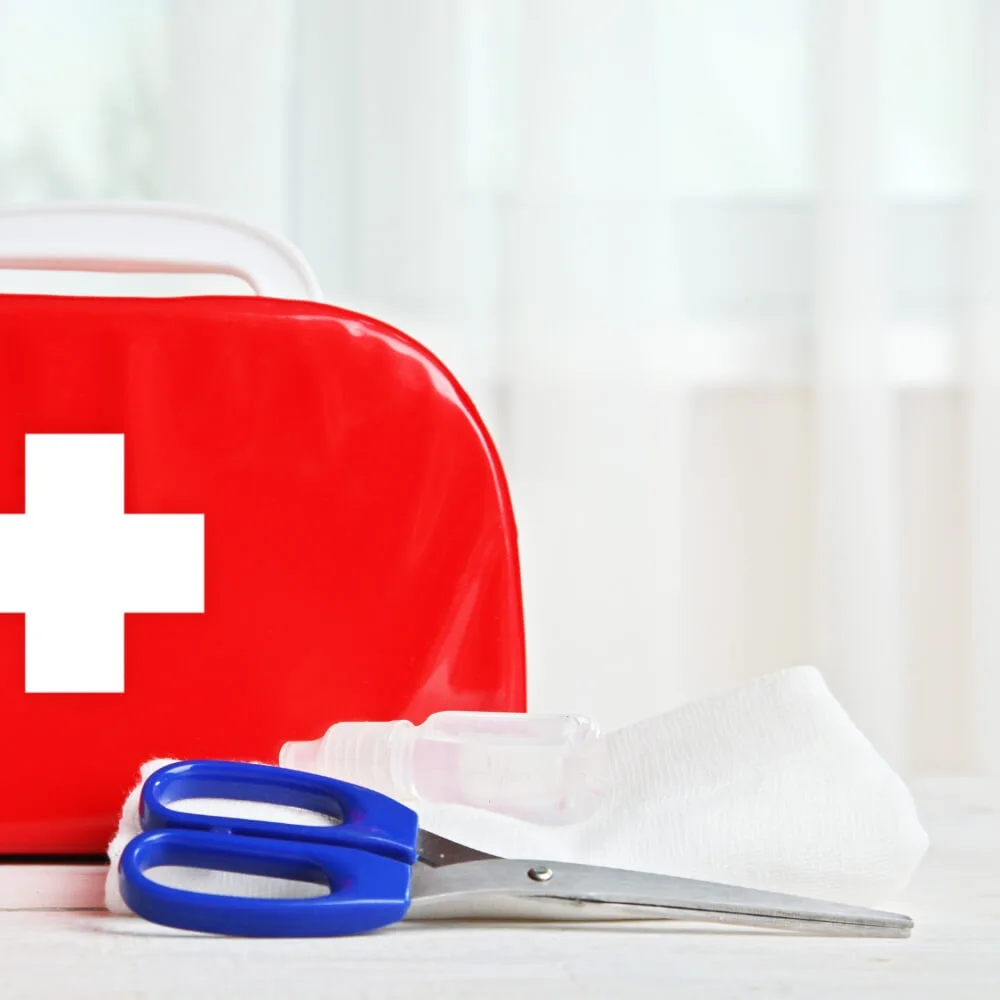
Scissors are an essential tool in a first aid kit. They are primarily used for cutting medical supplies such as adhesive tape, bandages, or gauze to the appropriate size. This can help ensure that dressings fit properly to a wound, contributing to better wound care and healing.
The scissors in a first aid kit are typically designed to be safe and practical for medical use. They are often made from stainless steel for durability and to allow for sterilization. Some medical scissors have rounded or blunt ends to prevent accidental injury when cutting near skin or removing bandages.
Here are some specific types of scissors you might find in a first aid kit:
- Bandage scissors: These have a flat, blunt bottom blade designed to slip beneath a bandage without cutting the skin.
- Medical shears: These are designed to cut through material quickly and are often used to cut away clothing in emergencies.
- Iris scissors: These are small, sharp scissors used for delicate tasks.
Scissors can also be used in emergencies where clothing must be removed to expose an injury. This can allow for quicker access to the wound and faster treatment, and it can also prevent further injury if trying to remove clothing normally from a severely injured area.
It’s important to keep the scissors in your first aid kit clean and to only use them for medical purposes. Using them for other tasks can dull or damage them, potentially introducing bacteria to a wound.
6. Disposable Gloves
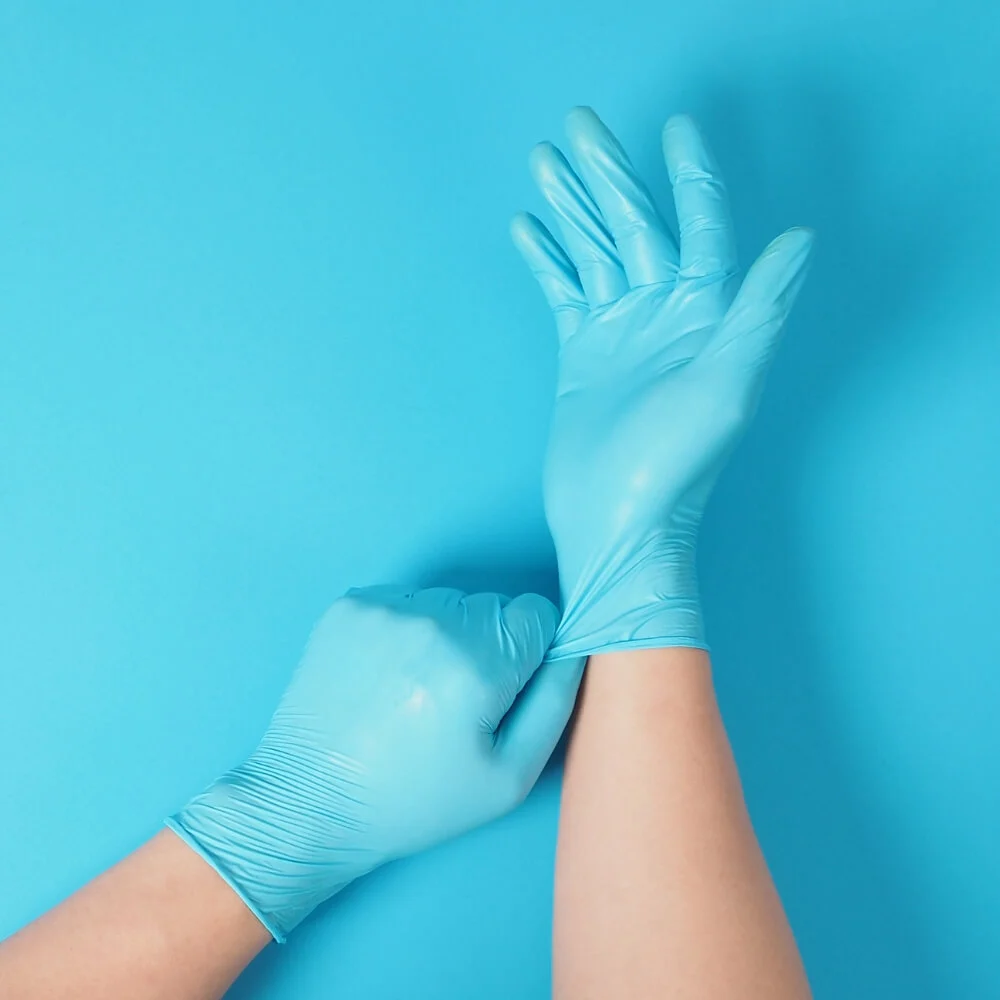
Disposable gloves are a crucial part of any first aid kit. They create a barrier between the caregiver and the patient, which helps to prevent the spread of infectious diseases. These gloves are typically made from latex, nitrile, or vinyl. However, nitrile is often preferred because it’s strong, resistant to punctures, and less likely to cause allergic reactions than latex.
Here’s why disposable gloves are so important:
- Protection for the Caregiver: Gloves protect the person providing first aid from contacting the patient’s body fluids (like blood, vomit, or mucus), which may contain infectious agents such as bacteria or viruses. This helps to prevent the spread of diseases, including serious ones like HIV, hepatitis B, and hepatitis C.
- Protection for the Patient: Wearing gloves also protects the patient. The human skin, including hands, often harbors bacteria and other microorganisms. Gloves provide a barrier preventing these from being transferred to the patient’s wounds, which can cause infections.
When using disposable gloves, make sure to put them on before you start administering first aid and remove them as soon as you’ve finished, taking care not to touch the outside of the gloves with your bare hands. After removing the gloves, dispose of them safely and wash your hands thoroughly.
Remember, gloves are single-use items and should not be washed or disinfected for reuse. If you must pause and continue providing first aid, or if the gloves get torn, you should replace them with a fresh pair.
7. Antiseptic Wipes Or Solution
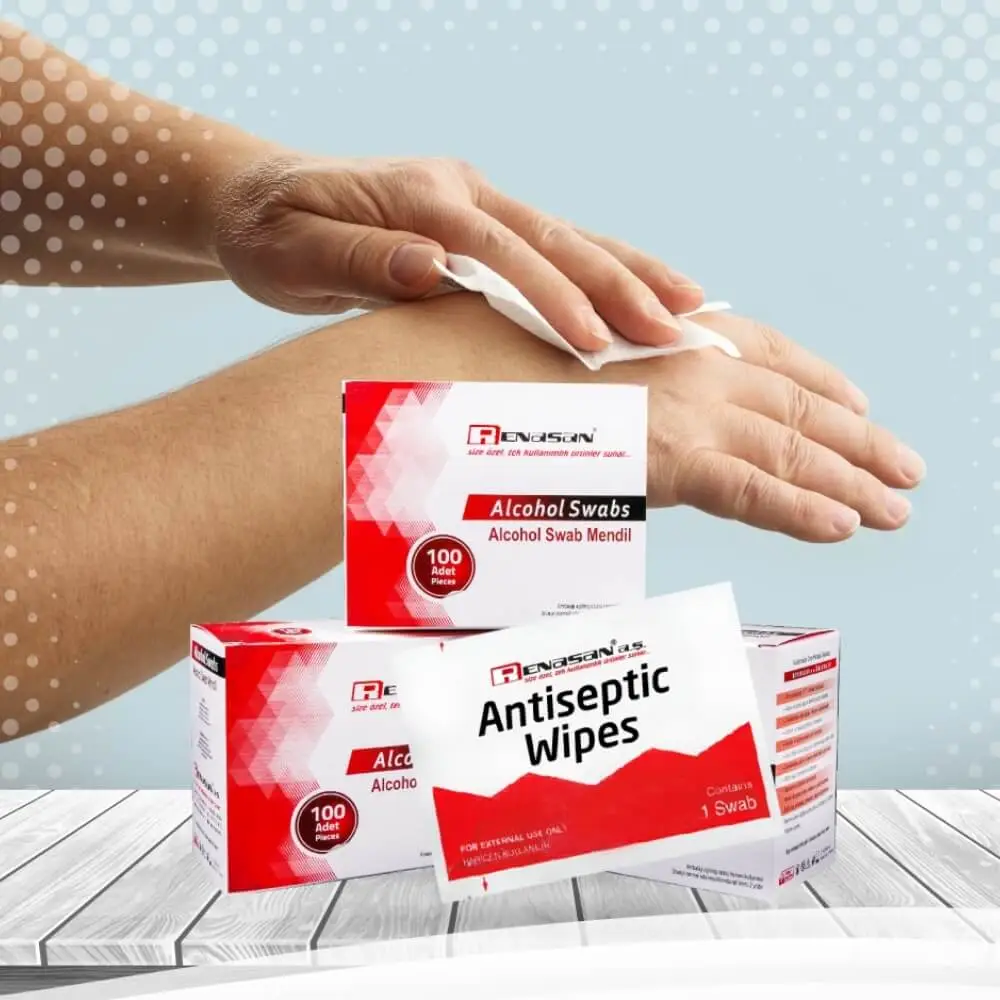
Antiseptic wipes or solutions are used to clean wounds and the surrounding skin to prevent infection. They kill or inhibit the growth of microorganisms, such as bacteria, fungi, and some viruses.
Here’s a bit more detail about each type:
- Antiseptic Wipes: These are pre-soaked pads that usually come in individual packets. They’re convenient and portable, making them a good first-aid kit choice. The most common type of antiseptic used in these wipes is benzalkonium chloride, but others like alcohol or iodine can also be used.
- Antiseptic Solutions: These liquids can be applied to a wound using a clean cloth or gauze. Common antiseptic solutions include hydrogen peroxide, povidone-iodine, and chlorhexidine gluconate.
When using antiseptics to clean a wound, you should gently clean the wound and the skin around it, taking care not to cause further injury. While it’s important to clean a wound, overuse of antiseptics can potentially damage skin and slow healing, so they should be used judiciously.
It’s also worth noting that some people can have allergic reactions to certain types of antiseptics. You should seek medical attention if you notice signs of an allergic reaction, such as increasing redness, swelling, or pain.
Remember, using antiseptics is only part of the wound care process. Once the wound is cleaned, it should be covered with a sterile dressing to keep it clean and protected as it heals.
8. Pain Relievers
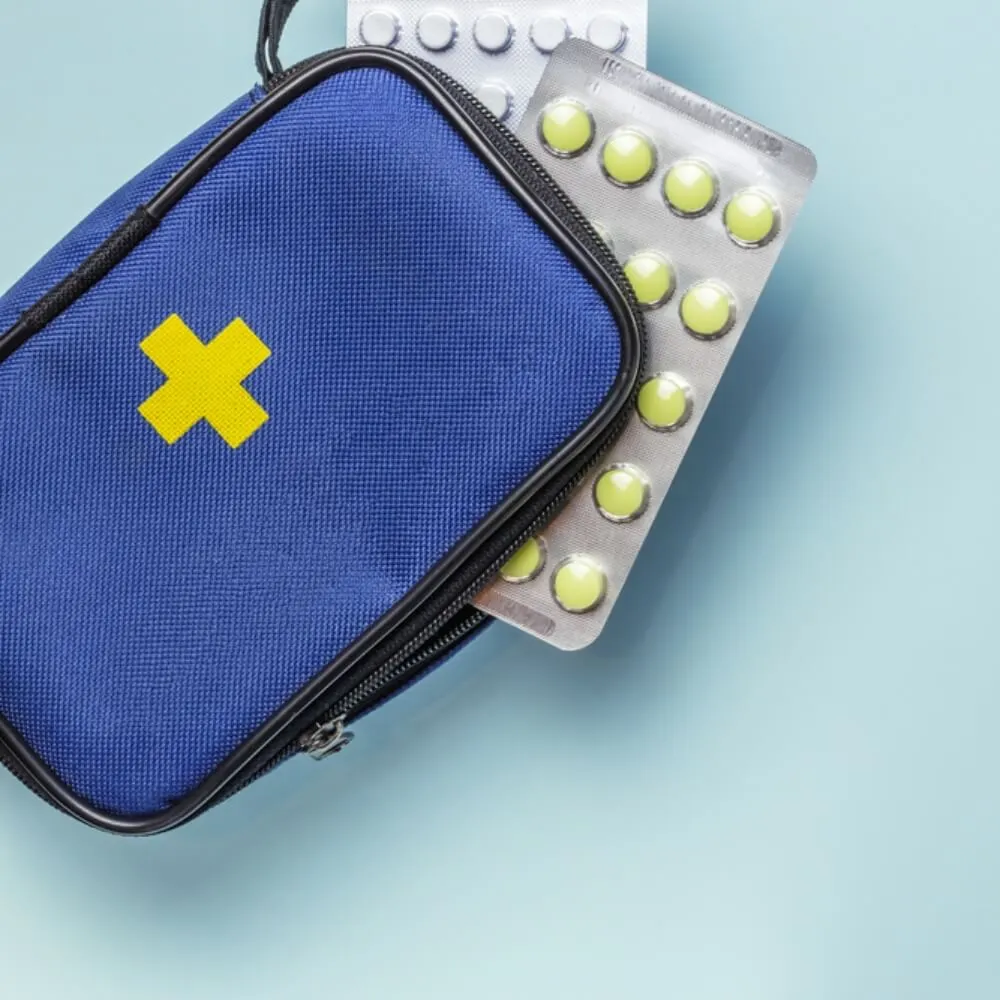
Over-the-counter (OTC) pain relievers can be purchased without a prescription and are used to alleviate minor to moderate pain. They can be a useful addition to a first aid kit for managing symptoms of common ailments or injuries. Here are the three types you mentioned in more detail:
- Aspirin is a non-steroidal anti-inflammatory drug (NSAID) that can relieve pain, reduce fever, and alleviate inflammation. It’s commonly used for headaches, toothaches, and minor body aches. Importantly, aspirin also has an antiplatelet effect that can help prevent heart attacks and strokes, and it is often recommended by doctors for patients at risk of these conditions.
- Acetaminophen: This medication relieves mild to moderate pain and reduces fever. It can be used for various conditions, such as headaches, muscle aches, arthritis, backache, toothaches, colds, and fevers. It differs from NSAIDs in that it doesn’t have anti-inflammatory effects.
- Ibuprofen (sold under brand names like Advil and Motrin): This is another NSAID, and it’s used to reduce fever and treat pain or inflammation caused by many conditions such as headache, toothache, back pain, menstrual cramps, or minor injury. Like aspirin, it can both relieve pain and reduce inflammation.
While these OTC pain relievers are generally safe for most people when used as directed, they can have side effects and interact with other medications. For instance, NSAIDs can sometimes cause stomach upset, increase the risk of stomach ulcers, and harm kidneys with long-term use. On the other hand, Acetaminophen is usually easier on the stomach than NSAIDs but can cause liver damage if the recommended dose is exceeded.
Always use these medications as directed on the label or as advised by a healthcare professional, and consider any individual health conditions or other medications being taken. It’s also crucial to remember that these medications can relieve symptoms but do not treat the underlying cause of the pain or inflammation.
9. Thermometer
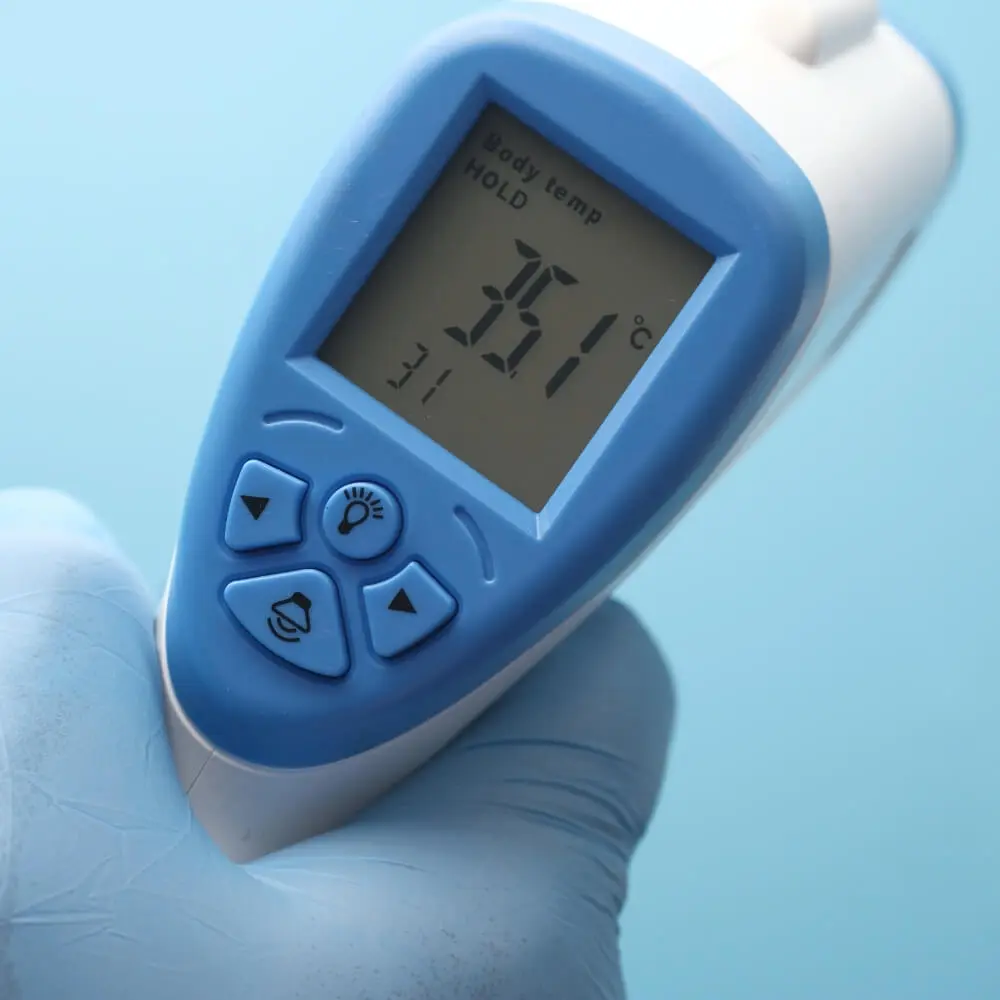
A thermometer is a device used to measure body temperature, which can be a useful indicator of illness or infection. In the context of a first aid kit, a thermometer can help determine if a person has a fever, a temporary increase in body temperature, often due to an illness.
Several types of thermometers can be used:
- Digital thermometers: These thermometers have electronic sensors that measure temperature. They can be used in the mouth (oral), rectum (rectal), or armpit (axillary). Digital thermometers are fast, accurate, and easy to use.
- Ear (tympanic) thermometers: These use an infrared sensor to measure the temperature inside the ear. They are quick and generally comfortable, but they may not be as accurate as digital thermometers if not used correctly.
- Forehead (temporal artery) thermometers: These also use an infrared scanner to measure the temperature of the temporal artery in the forehead. Like ear thermometers, they provide quick readings and are easy to use, but they can be more expensive than other types.
- Plastic strip thermometers: These are strips you place on a person’s forehead that change color to indicate temperature. They are very easy to use and do not require any battery power, but they are the least accurate and should not be used to measure temperature in a person who might be seriously ill.
Generally, a fever in an adult is usually considered a body temperature of 100.4°F (38°C) or higher. It’s an important infection symptom, but not all cases are serious. However, a high fever can indicate a serious illness, particularly in infants and young children.
As with all medical devices, it’s important to use thermometers as directed by the manufacturer and to keep them clean to ensure accuracy and prevent the spread of germs.
10. CPR Face Shield / Pocket Mask

A CPR face shield, also known as a pocket mask, is a device used during cardiopulmonary resuscitation (CPR). Its main function is to provide a barrier between the rescuer and the patient when giving rescue breaths, thereby reducing the risk of transmitting infectious diseases.
These devices are typically made of plastic or rubber and are designed to cover the patient’s mouth and nose. They often feature a one-way valve and filter. The one-way valve ensures that air only travels from the rescuer to the patient during rescue breaths, preventing the patient’s exhaled air (and any potential pathogens it may contain) from reaching the rescuer. The filter offers additional protection by trapping particles, fluids, or other contaminants that pass through the valve.
CPR face shields come in different designs. Some are flat, flexible plastic sheets that can be folded and stored in a small, portable case—ideal for a first aid kit. These typically have a small, one-way valve attached. Others are more rigid, mask-like devices that can be fitted with a one-way valve. These are often used by professional first responders and in medical facilities.
When using a CPR face shield or pocket mask, it’s essential to place it correctly over the patient’s mouth and nose to create an effective seal. This ensures that the rescue breaths go into the lungs rather than escaping around the sides of the mask.
CPR is a critical lifesaving technique that requires training to perform effectively and safely. I recommend enrolling in a certified first aid and CPR course if you haven’t already. These classes typically include instruction on using a CPR face shield or pocket mask.
Conclusion
In this blog post, we have explored the importance and composition of a first aid kit, an essential tool in every household, workplace, and vehicle. We’ve discovered that a first aid kit is more than just a box of medical supplies. It’s a crucial resource that can help manage minor injuries and illnesses and even be life-saving in more serious situations.
We’ve also highlighted ten key items that a well-stocked first aid kit should contain, from adhesive bandages and sterile gauze pads to a thermometer and a CPR face shield. Each item serves a unique purpose and is vital in providing initial care during health emergencies. Understanding each item’s function and correct usage is just as important as having them on hand.
Remember, first aid’s essence is in having the supplies ready and having the knowledge and confidence to use them effectively. Therefore, we recommend investing in first-aid training and assembling your kit. Preparedness is key – it’s better to have a first aid kit and not need it than to need it and not have it. As we’ve learned, this small box of essential items has the potential to make a huge difference when health emergencies strike.

